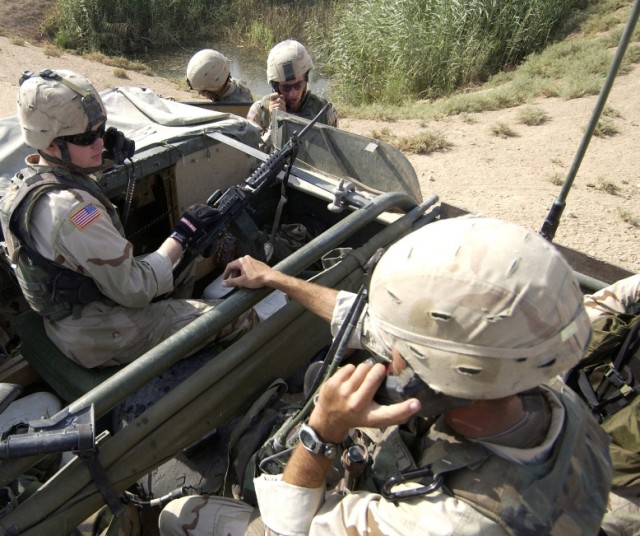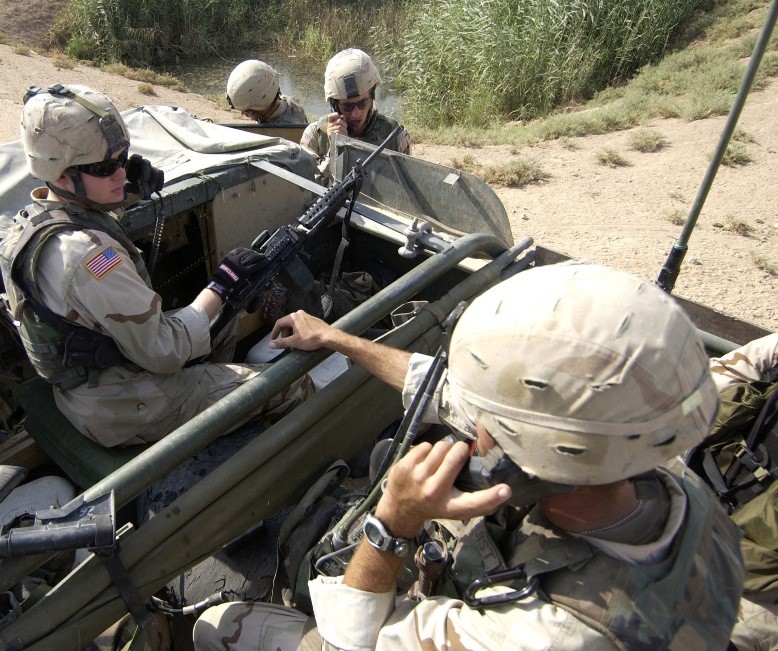FORT MONMOUTH, N.J. -- For a cook at a mess hall or a forward observer providing intelligence in the mountainous terrains of Afghanistan, a radio is a Warfighter's lifeline.
"Voice communications is first hand and essential," said Master Sgt. Daniel Massie, of the Army's 2nd Stryker Cavalry Regiment. "You're able to listen to that individual on the ground and really assess where he is coming from and execute your course of action."
Today, radios provide communications in the confines of urban Iraq, while satellite communications of the Warfighter Information Network-Tactical (WIN-T) Increment One provide battalion level and above Warfighters with the satellite communications necessary to communicate in the mountainous terrains of Afghanistan.
When integrated within WIN-T Increment One, High Capacity Line-of-Sight (HCLOS) radios combine communications within a user's sight range or line-of-sight, or those that expand beyond their line-of-sight.
Radios are a necessity for the Army in both Iraq and Afghanistan. Commanders who "see" and share a common view of the battlefield through today's digitized systems, need to "hear" the battle with a radio. Radios provide the close human interaction that a computer screen might lack. They have a wide range of uses in theater today, such as coordinating a raid in a tightly-packed environment or communicating the commander's intent over sizable terrain.
The High Capacity Line of Sight (HCLOS) radio is fielded by PM Command Posts (PM CP) in conjunction with WIN-T fieldings and installed with a HUMVEE shelter-mounted system. It connects to WIN-T Increment One through a fiber optic cable router, said James K. Goon, product director for Tactical Radio Communications Systems (PD TRCS), the organization to which HCLOS is assigned. HCLOS is used for long haul operations and sent through the WIN-T Increment One Ku band, so that users can communicate either within their scope of vision or even across the globe, Goon said.
With Increment Two, Warfighters at the battalion level will receive the Soldier Network Extension (SNE) for over-the-horizon communications and HCLOS capabilities for the ability to communicate within their field of vision. Company level Warfighters will be fielded only the SNE for beyond line-of-sight communications.
Today, WIN-T Increment One provides battalion-level and above Warfighters with the ability to connect to the Army's digitized systems, voice, data and video via satellite Internet connectivity. Residing on this at-the-quick-halt communications pipe are battle command systems, which allow Warfighters to obtain real-time updates of their buddies' whereabouts over a topographical map, plan and execute fires, manage the airspace and share information such as intelligence, weather and terrain.
Line-of-sight communications will remain a component of the WIN-T program, as future increments are fielded.
When surrounded by tall buildings in an urban, constricted environment a Soldier might not be able to establish the low takeoff angle necessary for satellite communications, Massie said.
"In this case, you must rely on other means of line-of-sight and beyond line-of-sight communications, such as HF communications, which is capable of beyond line-of-sight by bouncing the powerful signal off the ionosphere at steep angles," he said.
"The advancements in automatic link establishment and the high power of HF allows for more reliable voice than the traditional FM communications," he added.
TACSAT capabilities in Harris HF radios also allow the regiment to push data to extended ranges not available through FM communications.
The integration of beyond line-of-sight and line-of-sight communications was useful to Staff Sgt. Jose Arias during his recent deployment to Iraq. It provided a back-up communications system when one line went down. Synchronizing both forms of communications provides alternate paths for routing shared information.
"As a Signaleer, you always want to have more than one form of communication and that's exactly what that package enables, at least down at the squadron level, to be able to execute," said Arias, also of the 2nd Stryker Cavalry Regiment, headquartered in Vilseck, Germany.
"If your line-of-sight shot goes out, you still have that satellite path. So, you can push some data out and receive some; not at full capacity of course since they are both linked in to each other," said Arias."But it still enables you to keep that live feed in."
If the satellite link ceases to function, line-of-sight communications is available to pass a finer amount of data back and forth between a Soldier and their higher headquarters or the next data path, he said.
More than 6,000 PRC-148 handheld radios have already been fielded to theater in Afghanistan, Goon said.
Over-the-horizon radio systems such as the Tactical Satellite (TACSAT) relay communications through the mountainous terrains of Afghanistan, Goon said. Handheld radios are fielded for squads and platoons to use during patrols.
The Enhanced Position Location and Reporting System, which has many uses in theater in Iraq, is expected to be fielded to Afghanistan in the future. "EPLRS is a great example of the same radio, used by the various services in different ways, for different applications," said Col. Cris Boyd, project manager for Command Posts, to which PD TRCS is assigned.
On the ground, for instance, the Army and the United States Marine Corps, use EPLRS to provide position location information, independent and complementary of the Global Positioning System (GPS). They also use it to haul voice and data traffic between wheeled and tracked platforms, he said.
"In Land Warrior, we use EPLRS to connect Soldiers to each other, as well as the larger platform-based network," he said.
The United States Air Force (USAF) uses EPLRS to share data between fighter jets, such as fuel and weapons situations, targeting data, and information about the aircraft itself.
"When supporting Army or USMC units on the ground, the USAF radios switch their EPLRS into the ground mode, and they can 'see' EPLRS-equipped friendly forces on the ground, as well as collect the common operational picture (COP) of both friendly and adversary locations and types," Boyd said.
A COP refers to the ability of separate commanders to share intelligence and data and access it through a common view on a computer screen.
Using EPLRS, the Navy can guide landing craft from ships to shore, in all weather situations. This allows the ship to communicate with land base Tactical Operations Centers (TOCs) and share the operational picture which represents the situation on the shore, he said.
"All the services continue to experiment and improve operational use of sharing voice and data over the EPLRS radio system today," Boyd said.
The current force radios, which have been fielded since the first Gulf War, still satisfy users' requirements across the full spectrum of operations, Goon said. "I feel they will continue to meet the users' requirements until they are supplemented or replaced by JTRS," he said.
Joint Tactical Radio System is planned to be the next-generation voice-and-data radio used in field operations by the U.S. military.
PD TRCS is constantly evaluating enhancements offered by the radio manufacturers on the current force radios for increased robust waveforms such as Mobile Ad-hoc Networking waveforms, improved throughput and increased capability, Goon said.
Radios that might have borne the same name for years, have been updated incrementally to provide more capabilities to meet the challenges of today's digitized battlefield.
Separate radios are designed specifically for diverse missions.
"The types of radio equipment we provide can depend on the mission profile need in the area of operations," Goon said. In most cases, units are provided with various radio types, so that they can choose those that will meet their needs, he said.
"The units are given a full spectrum of radios from two megahertz in the HF (high frequency) world, all the way to the gigahertz range from the satellite communications and TACSAT world," Goon said. "So, they have a variety of tools in the toolbox that they can choose from to fulfill their mission.
"How they choose to deploy or use the equipment is determined by the unit's signal officers ," he said.
PRC-148 radios are used in Afghanistan for intra-squad communications such as those in patrols. Instead of hand signals, these type one encrypted radios - which use the SINCGARS waveform - allow foot patrolling Soldiers to communicate with their vehicle, Goon said.
The Multifunctional Information Distribution System (MIDS) receives the air tracks of incoming missiles and sends them to F-18 fixed-wing aircraft and the MIM-104 Patriot surface-to-air missile system on the ground so that they can respond, Goon said.
The Combat Survivor Evader Locator (CSEL) is used for the search and rescue of downed pilots. "Operational details are sensitive, but a downed pilot uses GPS embedded in CSEL to report their position via satellite," Boyd said. "When rescue aircraft are approaching the downed pilot, CSEL assists in geo-location and communications from the downed pilot to rescue aircraft with great accuracy."
A unit with additional needs can submit an operational needs statement, which is a means to report necessities for new or replacement equipment to the Army G3.
Once validated by the G3, the request is forwarded to the G8 for funding. PM Command Posts is then asked to provide the equipment to the unit.
PD TRCS is assigned to PM Command Posts of the Army's Program Executive Office for Command, Control and Communications-Tactical (PEO C3T).
"PM Command Posts' equipment spans from the TOC, to the lowest level of Soldier on the battlefield, carrying a radio for personal communications," Boyd said.
(This article appeared in Spectra, the magazine of the CECOM Life Cycle Management Command. To access the full issue in PDF format, 3.2 megabytes, click on the link appearing in the "Related Links" box at the start of the article.)


Social Sharing